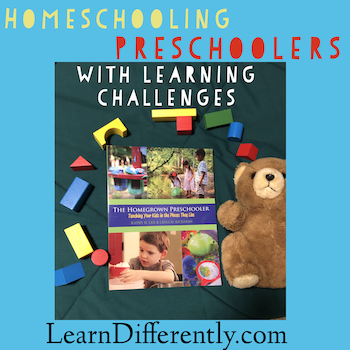Homeschooling Preschoolers with Learning Challenges: Review of The Homegrown Preschooler

Review by Kathy Kuhl of The Homegrown Preschooler by Kathy Lee Eggers and Lesli Richards
When I first saw The Homegrown Preschooler materials, I wanted to play with them! Authors Kathy Lee, Lesli Richards, and I were speaking at a homeschool convention. At their booth, they offered engaging activities for young children.
As I flipped through their curriculum, I wanted to buy it for my daughter to use with her child. But she hadn’t decided to homeschool. Also, her child was only a year old! So I restrained myself. (We grandmas do, occasionally.)
Now that they decided to homeschool, and I help a bit, I had an excuse to buy this book. Once I read it, I saw it would help many of you.

Before I tell you why this curriculum looks especially helpful for families with children with learning challenges–though it is written for everyone–a disclosure. When I asked about their December sale, Kathy & Lesli remembered me and graciously gave me their complete bundle. That gift did not buy a review or my good opinion. But I wanted you to know.
Homeschooling preschoolers when you’ve got no time to spare
When you’ve got 3-5 year olds, your first questions about preschool at home are probably “When?” “How?” I’ve talked to dedicated but weary parents who think they can’t teach a small child.
Many parents don’t realize they already are teaching their child at home.
When my daughter began considering homeschooling for kindergarten, she had doubts. But I smiled. She and her husband were already providing terrific, developmentally-appropriate experiences for their children. They were doing so many good things with their children already, they were practically homeschooling them.
That was the first point I appreciated about The Homegrown Preschooler. The authors don’t hand you a big stack of worksheets, a rigid schedule, and a guilt trip.
What does preschool at home look like? What my daughter and probably you are already doing–rich educational activities scattered through the day. It happens between diapers, meals, naps, and tears. It happens in playtime.
- reading aloud and talking about books they’d read,
- keeping crayons, markers, paper, and playdough nearby and giving the children plenty of time to enjoy them,
- playing with blocks and talking about what they played,
- pretending to eat what the children pretended to cook,
- singing and dancing together,
- letting them dig in the dirt out back, and make mud stews,
- taking walks in their neighborhood, along a lake, river, and trails, and noticing trees, plants, rocks, animals.
Informal, easy, fun and flexible
Notice I said “activities scattered through the day.” I like that Kathy Eggers and Lesli Richards help you create a flexible list of goals for the week. You don’t “do school” from 9 to 11 am–unless you want to and that suits your children.
If you don’t get through all you aimed to do, fine! If someone gets sick, maybe there’s no nature walk, but perhaps there’s more read aloud. So homeschooling preschoolers integrates into your daily life.
This is vital for parents taking small children to multiple appointments. Kathy and Lesli have walked that path and have a whole chapter on special needs–though the whole book is well-suited for our exceptional kids.
When parents of preschoolers with special needs ask me about homeschooling, I encourage this flexibility. Therapies and health form the foundation for learning. You don’t need to worry if you haven’t done everything with your five-year-old that they’d have done in a morning of kindergarten. If that child is spending many hours a day in ABA or Floortime, speech therapy, PT or OT, take it easy. You need time to read with them, be with them, and let them rest and enjoy unstructured playtime. (Therapy is work for them. They will be tired.)
The Homegrown Preschooler does some brainstorming for you and assembles wonderful resources in their books. (I tried their homemade play dough recipe with my granddaughter. We love it.)
Lots of these activities are portable, requiring few materials. They can be stowed in a ziplock bag and tossed in the diaper bag as you head to the doctor’s office or the store. Some are ideal for the car or other travel.
Location and setting: No place like home
The Homeschool Preschooler affirms that home is a great place for kids to learn. Education is part of your day, your life. In The Homegrown Preschooler, Kathy and Lesli point out that many good preschools try to resemble home: comfy chairs, rugs, and engaging activities. And unlike the teacher, you already know your child.
Why Kathy and Lesli homeschooled their preschoolers
Kathy explained that she loved teaching preschool and even been a preschool director. (She’s written books on it.) So when her son was born, she was eager for him to go enjoy preschool when he was old enough.
She didn’t plan to homeschool–until about 15 minutes into his first day of preschool! Then she realized that she didn’t want to miss out, either. So she brought him home and began incorporating into their day more of those fun, educational activities she loved when she taught preschool.
But Lesli never intended to homeschool or work with preschoolers, until her son was diagnosed with autism. To make their schedules flexible enough to get her son into therapy, she began homeschooling his big sister. To their surprise, they loved homeschool. When they decided to homeschool their son, he made progress beyond the experts’ expectations!
Multisensory
What first drew me to The Homegrown Preschooler was its multi-sensory activities. Many children are drawn to them. I still have fond memories of the shiny, vivid colors and gloopy texture of fingerpaint in first grade.
Our distractible kids need multisensory activities to keep them engaged. Our children with sensory integration challenges also need these activities, as do our children on the spectrum. At home we can provide ‘just enough’ stimulation and let them become acclimated to new sensations.
Our kids are all different, but there are probably textures, colors, smells, and sounds your child will love. So explore!
Preschool homeschool lets us do more of those extra activities the therapist suggests. And if they haven’t, ask! Your child’s occupational therapist, speech therapist, and physical therapist can be great sources of activities. And yes, Mom and Dad, that “counts” as school.
Recommendation for homeschooling preschoolers
I highly recommend The Homegrown Preschooler. After it was published, parents began asking them for help planning their weeks and so they also created the curricula (A Year of Playing Skillfully and A Summer of Playing Skillfully). They also have cool activity kits and bundles. So look at it all. And listen to their podcast, Play Skillfully.
And if you’re thinking you don’t have time to read this book, The Homegrown Preschooler, let me reassure you. It’s readable and well-organized. Half of its 200 pages are activities to try, organized topically. It’s full of photos of kids in action.
I’ve never done this before, but I’m so impressed with The Homegrown Preschooler that I’m including an affiliate link below. If you purchase anything from The Homegrown Preschooler using this link, 10% of your purchase will help fund this website and newsletter. That’s no extra charge to you. I appreciate your support.
I welcome your questions and comments.


Wonderful post! Just contacted them for additional information. Thank you. 🙂